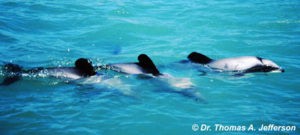 HECTOR'S DOLPHIN
HECTOR'S DOLPHIN
Cephalorhynchus hectori
(van Beneden, 1881)
DERIVATION: Hector was a New Zealand zoologist who first collected the dolphin species in 1869.
Hector’s dolphin is listed as one of the Top 10 Most-Endangered Species of Cetaceans in the world at No. 6, and is designated as EN (facing a very high risk of extinction in the wild). It was named after Sir James Hector (1834-1907), the curator of the Colonial Museum in Wellington, which is now the Museum of New Zealand.
There are two subspecies recognized: C. hectori hectori along the South Island of New Zealand, and C. hectori maui along the west coast of the North Island. It is only endemic to New Zealand which gives it one of the most restricted cetacean distributions. They are found in shallow coastal waters. In the summer, they are strongly concentrated in shallow, turbid waters close to shore; in the winter they are more widely dispersed.
There are three genetically-separate populations in the South Island, and the one small North Island population that has recently been named as a separate subspecies (C.h. maui).
Hector’s is predominantly a gray animal, but much of the face is dark gray to black. Its complex markings include a dark “collar,” which extends from the area above the eyes to behind the blowhole. The throat and most of the lower jaw, as well as the belly, are white. The black marking of the face is continuous with that of the flippers. It continues in a line on the ventrum, making a V at the midline. Part of the head starting just behind the black lower jaw tip is white, as is the area from just behind the flippers to the urogenital area. White patches also extend up the sides.
The dorsal fin is low, but relatively broad and rounded and some people say that it reminds them of Mickey Mouse ears, with the leading edge rising at a shallow angle from the back and a notch at the posterior base. Flippers are small and rounded at the tips.
Hector’s are active animals, readily bow-riding or porpoising next to vessels. When leaping from the sea, individuals will often land on their side, creating a loud splash (their vertical and horizontal dives are much less noisy).
Physical Characteristics:
- Have a blunt head with a slight beak, and its mouth contains 24-31 fine, pointed teeth in the upper and lower jaws.
- Reach lengths of 1.63 m (females); 1.46 m (males). Females are somewhat larger than the males. A meter is 3.281 feet.
- Engage in opportunistic feeding on several species of small fish and squid.
- Live in groups of 2-8 dolphins; occasionally, large groups of up to 50 animals have been noted.
- Gestation lasts 10-11 months. They reach sexual maturity between 5 and 9 years; adult females give birth every 2-4 years.
- Can live up to 20 years.
Recent surveys show the South Island Hector’s population numbers collectively about 7,300 individuals; the North Island population is estimated at no more than about 100 animals. Both populations have been declining rapidly over the last 30 years, as the species faces serious threats from humans. The most serious problem is recreational gillnet fishing. The number of animals killed has been reduced a bit with the establishment of two marine sanctuaries.
